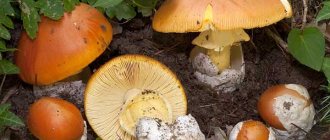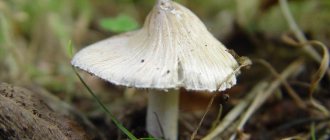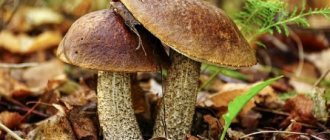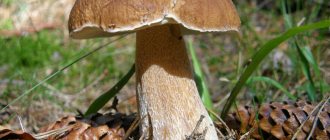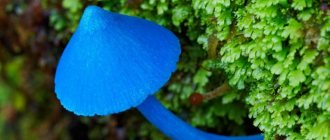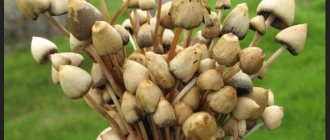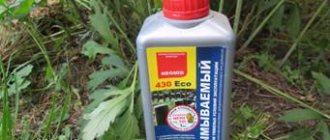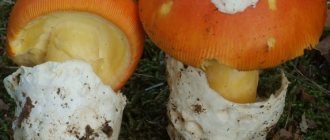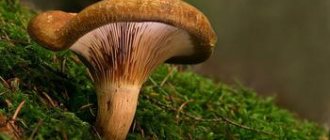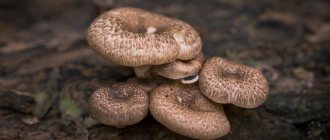There is probably no person in the world who has never in his life watched films about zombies - dead creatures that, for completely different reasons, came to life and began to hunt living creatures. Some people find it hard to believe that the living dead actually exist and are ants infected with a parasitic fungus called cordyceps. Previously, scientists were sure that a dangerous fungus controls the bodies of insects by penetrating their brains, but everything turned out to be much simpler - it only controls the muscles.
American biologists learned about this by studying the behavior of a parasitic fungus of the species Ophiocordyceps. During their observations, they found out that once on the body of an ant, fungal spores pierce its hard shell and penetrate inside the insect, which is full of sticky substance. It contains the so-called hyphal tubes, which penetrate the entire body of the ant and even the muscles. By seizing control of the muscles, the fungus can control the movements of the insect.
Fungus turns insects into zombies
Using a microscope, scientists noticed that the fungus completely destroys the sarcolemma - the surface of muscle fibers. At the same time, the junctions between the muscles and the brain remain intact and unharmed, and this suggests that the parasite somehow still interacts with brain impulses. How exactly this happens is not yet clear to scientists, but they now know for sure that the transformation of an ant into a zombie occurs without direct penetration of the fungus into the brain.
Ant muscles captured by parasitic fungus
Having seized control of the ant's body, the cordyceps fungus forces it to climb to the highest branch. After reaching the top, something even more amazing happens - obeying the commands of the fungus, the ant bites the branch with such force that its head is torn apart. The insect, of course, finally dies, but the spores of the parasitic fungus that have accumulated in its head fall down from the high branch and infect the ants below.
This is interesting: Scientists told where to hide from zombies
The fact that the fungus turns insects into zombies without directly affecting the brain, but first of all by taking over the muscles, is a great scientific discovery. Despite this, parasitic fungi still remain an extremely mysterious kingdom of wildlife with features of both plants and animals. For example, scientists still don't understand why small bubbles form inside infected insects. Some experts believe that these tiny particles secrete substances necessary to control other people's bodies. This may be true, but it is important to study this issue in more detail.
Zombifying mushrooms deprived ants of sleep and sense of smell
Dead ant infected with the fungus Ophiocordyceps sp.
Katja Schulz/Flickr
To turn an ant into a docile zombie, the parasitic cordyceps fungus disrupts its circadian rhythm, odor system, and neurotransmitter transmission. As a result, the insect leaves the anthill, climbs onto a suitable plant and hangs on it until its death. This allows the fungus to reach the optimal location for the spread of spores. G3: Genes, Genomes, Genetics were able to describe the manipulations of Cordyceps at the molecular genetic level
.
Many parasites skillfully manipulate the behavior of their host to increase their chances of survival and procreation. For example, some species of cordyceps mushrooms from the genus Ophiocordyceps
cause infected ants to leave the colony, climb the plant and hang on it, holding on with their jaws. After the death of the insect, the fruiting body of the fungus sprouts from it. Essentially, Cordyceps turns the host into a vehicle to travel to a location that is ideal for spore maturation and dissemination.
The dramatic relationship between cordyceps and ants has become widely known not only among biologists, but also in popular culture. However, scientists still do not have an exact answer as to how exactly the fungus controls the behavior of its host.
Researchers led by Ian Will from the University of Central Florida decided to look at this issue at the molecular genetic level. They focused on Cordyceps O. camponoti-floridani
and its specific host - the carpenter ant
Camponotus floridanus
. The insects were infected with fungal spores and tested how this would affect the activity of the genes of both species. To do this, scientists sequenced the RNA of the parasite and host three times - before infection, after infection and after the death of the ant.
The analysis identified a range of candidate genes that allow Cordyceps to produce toxins, enzymes and secondary metabolites to control host behavior. Similarly, genes that serve as targets for the parasite were isolated in the ant genome.
Researchers have demonstrated that the fungus attacks several important functions of the host's nervous system. For example, it disrupts the ants' daily routine, disrupting the functioning of genes associated with circadian rhythms. The parasite has an even more destructive effect on the victim’s sense of smell, the main channel of its communication with its relatives. As a result, the infected individual loses contact with the colony, moves far away from it and does not return on time. Cordyceps' interference with neurotransmitters has an additional effect.
At the last stage, the data obtained were compared with the results of a similar study, which was carried out with another parasite-host pair - O. kimflemingiae
and
C. castaneus
. It turned out that the relationships between different species of Cordyceps and ants are quite similar from a molecular genetic point of view. Perhaps parasitic fungi acquired the ability to zombie ants once, and then adjusted it to specific species.
Cordyceps are far from the only parasites capable of manipulating the behavior of their hosts. Today, scientists know that this trait is widespread in nature. You can learn more about the creatures that turn their victims into real zombies from our Resident Evil test.
Sergey Kolenov
Parasitic mushrooms in Russia
No matter how unexpected it may sound, parasitic fungi also exist in Russia. Everyone has probably seen them - in the forest, on the bark of some trees you can see quite large growths. They are tinder fungi, which, although they do not infect people and animals for subsequent control of their bodies, are still parasites.
Tinder fungus
The spores of this fungus penetrate into the wood through crevices and spread throughout the wood, destroying it. Trees infected with tinder fungus easily break and, accordingly, do not live as long as they could.
Research and discovery
To conduct the study, the scientists infected a carpenter ant with O. unilateralis. However, some individuals received a dose of a less dangerous, non-zombifying fungal pathogen known as Beauveria bassiana - they served as a control group. By comparing the dynamics of the disease caused by these two fungi, the researchers were able to identify specific physiological manifestations of O. unilateralis activity in ants. Using electron microscopes, the team created a 3D model to determine the location, abundance and activity of fungal tissues inside the insects' bodies. To do this, samples of these tissues measuring only 50 nm were taken, and observation was carried out using instruments capable of monitoring and processing images at a frequency of 2000 times in 24 hours. To analyze the impressive volume of incoming data, scientists turned to artificial intelligence: an algorithm based on deep learning, during the analysis, highlighted differences in the activities of fungal and ant cells. This allowed the researchers to clearly see at what stage of the disease the body tissues still belonged to the insect, and where they had already been transformed into a fungus.
0
The results were both extremely interesting and frightening. O. unilateralis cells spread throughout the ant's body, from the head and thorax to the abdomen and legs. Moreover, they were interconnected, creating a kind of collective biological network that controlled the behavior of the ants. Hughes noted that eventually a high percentage of the cells in the host's body turned into fungal cells - which literally made the insect part of itself. But the most amazing thing was that the brain tissue remained... untouched. "Normally, animal behavior is controlled by the brain, which transmits signals to the muscles, but our findings show that the parasite controls the host's behavior through peripheral systems," explains Hughes. "Almost like a puppeteer pulling strings to control the movements of a puppet, the fungus also controls the ant's muscles, manipulating the host's limbs and mandibles."
How do zombie spiders appear?
Not only insects, but also arthropod spiders can turn into the walking dead. They are known to turn into zombies after being attacked by a special type of wasp that lays eggs on their backs. The hatched larvae inject a substance into the spiders' bodies that causes them to produce a particularly strong type of web, from which a safe cocoon is woven for the quiet development of wasp larvae.
Are you afraid of the living dead? Anti-zombie weapons sold in the US
If you are interested in science and technology news, subscribe to our Telegram channel. There you will find announcements of the latest materials from our site!
Medicinal potential
Naturally, the question arises: can Cordyceps unilateral parasitize on humans? No, of course, but it can be very useful for people.
The biologically active metabolites contained in it have a number of properties important for humans, which have been used for many centuries in Asian and, in particular, Chinese medicine.
- Antioxidant properties . Clinical studies have confirmed the powerful antioxidant effects of Cordyceps due to the presence of polyphenolic and flavonoid compounds in its composition, which protect our body from the negative effects of free radicals.
- Anti-inflammatory effect . Cordyceps extract has pronounced inhibitory properties regarding the generation of superoxide anion, as well as the release of elastase. This is the basis for the use of powder to relieve inflammation.
- Treatment of bronchial asthma and respiratory diseases . Cordyceps unilateral has a unique ability to absorb oxygen in the body, thereby improving the respiratory process. Mushroom powder can be recommended as an alternative remedy for the treatment of bronchial asthma.
- Immunomodulatory properties . Based on recent studies, the positive effects of cordyceps on the immune system, increasing vitality and endurance of the body have been proven. Polysaccharides that scientists isolated from the fruiting body of the mushroom have demonstrated the ability to induce an immune response in the human body and activate the immune system.
Love triangle
The parasitic protist Toxoplasma gondii is the most terrible of the parasites presented here. Why? Yes, because they can get into and live in the body of an unsuspecting person. Toxoplasma gondii primarily lives in the bodies of cats, whose feces contain parasite eggs. Rats and mice eat cat feces (yes, they do that), after which the parasite enters the rodent's brain, causing it to become less afraid of the smell of cats. Therefore, small rodents become easy prey for cats. The parasite gets inside the cats and the process begins again. This parasite can cause flu-like symptoms in humans. For healthy people, it is not deadly, but for children in the womb and people with weakened immune systems, the parasite poses a serious danger, even death. In order for the parasite to enter the human bloodstream, it is not at all necessary to eat cat shit; it is enough to simply eat an unwashed fruit or vegetable.
Cordyceps on iHerb
Om Mushrooms, Cordyceps, Certified 100% Organic Mushroom Powder, 7.05 oz (200 g)
iherb.com
RUB 2,700
Buy now
California Gold Nutrition, Fungiology, Cordyceps Complex, 90 Capsules Plantcap
iherb.com
938 rub.
Buy now
Doctor's Best, Ultra Cordyceps Plus, 60 Vegetarian Capsules
iherb.com
RUB 1,034
Buy now
Solaray, Organic Grown Fermented Cordyceps, 500 mg, 60 VegCaps
iherb.com
RUB 1,309
Buy now
Planetary Herbals, Cordyceps 450, Full Spectrum, 450 mg, 120 Tablets
iherb.com
RUB 1,159
Buy now
Now Foods, Cordyceps, 750 mg, 90 Veggie Caps
iherb.com
RUB 1,206
Buy now
Zombie crabs
Crabs themselves are pretty scary creatures, but zombie crabs are even scarier. The parasite Sacculina carcini, known as sacculina, enters the crab's bloodstream and begins to grow inside its body. Sacculina emerges from the reproductive organs of female crabs instead of eggs, and the female begins to take care of the parasite as if it were her own eggs. If sacculina enters the body of a male, then he develops a characteristic abdomen like a female, and he begins to behave “like a woman.” Sacculina castrates the crab, rendering it sterile, and then completely takes over its mind and body, thereby creating a zombie crab. Eventually the crab climbs onto a high stone, closer to the surface, and begins to swing its claws, thereby helping the sacculina larva get out of its body and into the sea current, the body of the used crab becomes no longer needed.
3. The emerald cockroach wasp zombifies cockroaches
The emerald cockroach wasp (Ampulex compressa) parasitizes cockroaches, turning them into zombies before laying eggs on them. A female emerald cockroach wasp finds a cockroach and stings it first to temporarily paralyze it, and then a second time to inject venom into its brain. The venom consists of neurotoxins that serve to block the initiation of complex movements. Once the poison begins to act, the wasp controls the cockroach using its antennae. She leads the cockroach to a prepared nest, where she lays an egg on its stomach. After hatching, the larva feeds on the cockroach and forms a cocoon inside its body. The adult wasp eventually emerges from the cocoon and leaves behind a dead host to begin the cycle again.
Flowers before death
Goldenrod soft beetles lead a lifestyle quite typical for beetles: they fly across meadows, feeding on certain types of flowers. However, it is in flowers that a mortal danger awaits them in the form of the fungus Eryniopsis lampyridarum. Beetles infected with the fungus bite tightly into the stem and die.
But the worst thing begins after: after 15-20 hours, the dead beetle spreads its wings, and its abdomen swells due to the fungus that has settled inside. If such a metamorphosis occurs with a female soft calf, it may seem to an unsuspecting male from the outside that she is ready to reproduce (spread wings for soft calfs are a sign of attractiveness). During the mating attempt, the fungus infects the unlucky groom.
Photo: Donald C. Steinkraus et al.
Scientists first discovered soft beetles infected with the fungus back in 1996. Then, among the 446 dead individuals found, every fifth died due to Eryniopsis lampyridarum.
Now scientists want to check how reducing the attractiveness of “dead brides” will affect the likelihood of infection - they will try to fix their wings.
Zombie shrimp
In fact, gammarids are not exactly shrimp, but they are very similar to them. These guys are the favorite prey of a certain type of worm, which attaches itself to the crustacean's mouth with its sharp hooks. Once a gammarid is captured, the parasitic worm releases chemicals into its brain that completely discourage the crustacean from mating, forcing it to swim to the surface of the water. Swimming on the surface, gammarids become easy prey for ducks and other birds, and once inside their bellies, they lay their eggs, completing their life cycle.
"Alien" in the language
Prepare yourself for real nightmares, because this parasite is truly terrifying. The parasitic crustacean Cymothoa exigua, also known as the tongue-eating woodlouse, does some truly incredible things. Having entered the body of the spotted pink snapper through the gills, the parasite grabs its tongue with its sharp legs and drinks blood from it. After the tongue atrophies, the parasite latches onto the tongue stump and completely replaces the fish's tongue. Yes, yes, you heard right, the parasite completely and completely functionally replaces the host’s tongue. After this, the parasite no longer harms the host by feeding on its mucus. This parasite is not dangerous to humans, but there is a possibility of a bite.
Contraindications
Although Cordyceps unilateral has long been part of the arsenal of Eastern medicine, its scientific study is just beginning, and it is impossible to accurately predict what reaction it will cause in a particular person.
The mechanism of its effect on the body is not yet precisely known, so it should not be surprising that serious experts are not particularly enthusiastic about information about this miracle mushroom. And this is quite natural, because it is unknown what side effects this can cause.
On the contrary, the Internet is full of praise and calls to purchase cordyceps from reliable sites that sell it directly from China.
It is possible that if the recommendations and dosage are followed, such a course will turn out to be safe and even useful, but contraindications should be taken into account.
In any case, pregnant women and nursing mothers should not rely on advertising or use a little-studied remedy. Cordyceps is also not recommended for autoimmune diseases (rheumatoid arthritis, multiple atherosclerosis, lupus erythematosus, etc.).
You should not take it in combination with immunosuppressants of the cyclophosphamide group, as their interaction can cause an allergic reaction, as well as disorders of the immune system.
"God's Zombies"
The wasps Dinocampus coccinellae lay their larvae in the bodies of ladybirds, after which the larva develops and begins to eat the insides of the insect, including its genitals. Despite being eaten from the inside, the ladybug remains fully functional. Having reached a certain stage of its development, the parasitic larva begins to pupate in the body of the ladybug, the cocoon of which then sticks out from the back of the insect’s body. The larva takes possession of the ladybug's mind, and she begins to protect the parasite's cocoon from the beetles trying to eat it.
It is possible to defeat parasites!
Antiparasitic Complex® - Reliable and safe removal of parasites in 21 days!
- The composition includes only natural ingredients;
- Does not cause side effects;
- Absolutely safe;
- Protects the liver, heart, lungs, stomach, skin from parasites;
- Removes waste products of parasites from the body.
- Effectively destroys most types of helminths in 21 days.
There is now a preferential program for free packaging. Read expert opinion.
Read further:
How the parasite and host enter into a relationship, the mechanism of interaction
Pathogenic fungal spores: detection and destruction on nails
Oak bark against parasites: beneficial properties and methods of use
How the roundworm uses oxygen in the process of breathing, roundworm breathing
Plasmodium falciparum: morphology, intermediate host, treatment methods
Cloves for parasites: how to take correctly, beneficial properties, recipes and contraindications
Killers of ants, cicadas and caterpillars
Once the mushroom lands on an ant, it hypnotizes it, causing the insect to seek a specific location to die. Usually this is some kind of leaf at a distance of about 25 cm from the ground. After the ant crawls to a given place, it clings to the leaf with its jaw and dies. At this time, the fungus begins to actively develop and prepare for its future reproduction. The parasite does not touch the muscles of the ant so that it continues to stay on the leaf, and the insides of the insect turn into sugar - this is the most beneficial environment for the growth of the fungus. After a week, the ant grows a shoot with a ball, which is intended for reproduction. It contains spores that spread over a distance of up to one square meter and infect new insects. An insect that gets hit by a spore is doomed. Often, an insect dies near its anthill, which in the future leads to the death of all other ants.
Fungi parasitize cicadas, but only certain ones - seventeen-year-old ones. The parasite falls on insects from the ground and begins to develop in it until the victim dies. This process takes about a week or so. The insect dies from waste products secreted by the fungus - various toxins and harmful substances. The abdomen of the cicada is completely filled with mycelium and becomes like crumbling chalk. Then the parasite falls back onto the ground and awaits its next victim.
After a fungal spore gets into the caterpillar in the summer, it lives there all winter, and in the spring it germinates, resembling a blade of grass. Gradually the insect dies, but does not decompose, having its original appearance. This is due to the fact that the parasite has many antibacterial substances. In addition, the mushroom has a huge amount of various enzymes, vitamins and microelements, therefore it is the most valuable medicine in China. The conditions in which this parasite develops are very harsh: constant cold and melting glaciers of Tibet. To survive, the fungus produces many useful substances that are subsequently used by humans. No medicine in the world can compare in terms of the number of useful enzymes. The price of the medicine that is subsequently prepared from this parasite is very high.

